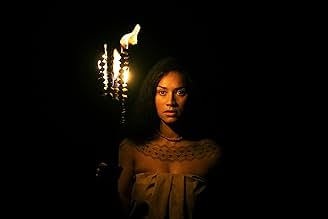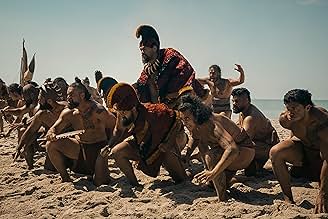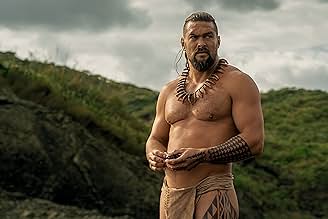A thrilling, unprecedented telling of the unification of the Hawaiian Islands from an indigenous perspective. A Hawaiian war chief joins a bloody campaign to unite the warring islands in ord... Read allA thrilling, unprecedented telling of the unification of the Hawaiian Islands from an indigenous perspective. A Hawaiian war chief joins a bloody campaign to unite the warring islands in order to save them from the threat of colonization.A thrilling, unprecedented telling of the unification of the Hawaiian Islands from an indigenous perspective. A Hawaiian war chief joins a bloody campaign to unite the warring islands in order to save them from the threat of colonization.
Browse episodes
Featured reviews
Jason Momoa is back with a new series called Chief of War and it's some of the best work he's done in his entire career. It's about four kingdoms in Hawaii that are divided by a war. To prevent more killing and bloodshed, a Hawaiian war chief (Momoa) goes on a mission to unite his people against a new threat that's coming to their land. What follows is an incredible true story and one of the best new shows of the year. It currently has a 94% on Rotten Tomatoes so the reviews have been great. Chief of War reminds me of the Hawaiian version of Shogun. Momoa is the standout here but the entire cast is incredible. I can see this show not only being nominated for a ton of awards but winning them too.
Wow seriously ignore the dumb negative reviews clearly most of those are folks who did not even watch any of the episodes so far. Check out this new epic story - I'm hooked!
Chief of War is more than just a historical drama-it's a cinematic homage to a culture rarely given this much screen time, and it doesn't waste a single frame in telling its story with reverence, grit, and heart.
Scenery and Cinematography: A Visual Masterpiece
From the opening shots, the Hawaiian islands (and yes I know where it was filmed so what it's beautiful and works setting the right tone) are treated not merely as a backdrop but as a living character. The lush greens, volcanic reds, and expansive blues of the Pacific are captured in breathtaking wide-angle shots and sweeping aerial views. The cinematography is meticulous, almost meditative at times, with deliberate pacing that draws you into the natural rhythm of island life-and the turbulent undercurrents of war.
Whether it's mist-covered cliffs, churning surf, or smoke rising from tribal fires, every scene feels handcrafted. Natural light is used to stunning effect, particularly in golden-hour battles and quiet conversations under torchlight. It's immersive and evocative-clearly influenced by Terrence Malick and The Last of the Mohicans-but with a distinctly Polynesian heartbeat.
Music and Sound Design: A Spiritual Undercurrent - Zimmer sets the mood
The score blends traditional Polynesian instruments with modern cinematic cues to elevate tension and emotion without overpowering the moment. The use of indigenous chants, percussion, and melodic motifs grounds the story in authenticity and identity. Music here doesn't just accompany the narrative-it anchors it. In quieter scenes, the ambient sound of the ocean or jungle builds a visceral sense of place that never lets you forget where you are: this is Hawaii, before the West came calling.
Characterization: Layered, Human, and Authentic
Jason Momoa leads with raw intensity, but it's his restraint in key moments that makes his performance resonate. He embodies a man torn between tradition and transformation-between chief and warrior, between vengeance and vision. The supporting cast is equally strong, particularly the women, who are not sidelined but integral to the emotional and political stakes of the story.
The show avoids turning characters into mere archetypes. Even the antagonists are layered, with motivations rooted in power, fear, or survival, rather than cartoonish villainy. Tribal alliances, family dynamics, and individual ambition collide with believable complexity.
Storytelling: Epic in Scope, Intimate in Heart
At its core, Chief of War tells a story about identity-cultural, personal, and generational. It balances sweeping historical events with intimate personal struggles. The pacing leans slow-burn in the best way, giving characters and conflicts time to breathe.
The writing doesn't spoon-feed exposition, trusting the audience to stay engaged and follow along as customs, rituals, and politics unfold naturally. This lends the show a sense of realism and weight, making the betrayals more heartbreaking and the triumphs more earned.
Themes of legacy, honor, resistance, and sacrifice are woven throughout without becoming didactic. And while the show doesn't shy away from brutality, it also leaves room for beauty, love, and quiet reflection.
Final Verdict:
Chief of War is a powerful, respectful, and beautifully crafted series that elevates indigenous storytelling to a new cinematic high. It's a rare show that educates while it entertains, moves you while it mesmerizes. With its gripping narrative, stunning visuals, rich characters, and soulful score, it's a must-watch for fans of historical epics and cultural storytelling done right.
Chief of War is more than just a historical drama-it's a cinematic homage to a culture rarely given this much screen time, and it doesn't waste a single frame in telling its story with reverence, grit, and heart.
Scenery and Cinematography: A Visual Masterpiece
From the opening shots, the Hawaiian islands (and yes I know where it was filmed so what it's beautiful and works setting the right tone) are treated not merely as a backdrop but as a living character. The lush greens, volcanic reds, and expansive blues of the Pacific are captured in breathtaking wide-angle shots and sweeping aerial views. The cinematography is meticulous, almost meditative at times, with deliberate pacing that draws you into the natural rhythm of island life-and the turbulent undercurrents of war.
Whether it's mist-covered cliffs, churning surf, or smoke rising from tribal fires, every scene feels handcrafted. Natural light is used to stunning effect, particularly in golden-hour battles and quiet conversations under torchlight. It's immersive and evocative-clearly influenced by Terrence Malick and The Last of the Mohicans-but with a distinctly Polynesian heartbeat.
Music and Sound Design: A Spiritual Undercurrent - Zimmer sets the mood
The score blends traditional Polynesian instruments with modern cinematic cues to elevate tension and emotion without overpowering the moment. The use of indigenous chants, percussion, and melodic motifs grounds the story in authenticity and identity. Music here doesn't just accompany the narrative-it anchors it. In quieter scenes, the ambient sound of the ocean or jungle builds a visceral sense of place that never lets you forget where you are: this is Hawaii, before the West came calling.
Characterization: Layered, Human, and Authentic
Jason Momoa leads with raw intensity, but it's his restraint in key moments that makes his performance resonate. He embodies a man torn between tradition and transformation-between chief and warrior, between vengeance and vision. The supporting cast is equally strong, particularly the women, who are not sidelined but integral to the emotional and political stakes of the story.
The show avoids turning characters into mere archetypes. Even the antagonists are layered, with motivations rooted in power, fear, or survival, rather than cartoonish villainy. Tribal alliances, family dynamics, and individual ambition collide with believable complexity.
Storytelling: Epic in Scope, Intimate in Heart
At its core, Chief of War tells a story about identity-cultural, personal, and generational. It balances sweeping historical events with intimate personal struggles. The pacing leans slow-burn in the best way, giving characters and conflicts time to breathe.
The writing doesn't spoon-feed exposition, trusting the audience to stay engaged and follow along as customs, rituals, and politics unfold naturally. This lends the show a sense of realism and weight, making the betrayals more heartbreaking and the triumphs more earned.
Themes of legacy, honor, resistance, and sacrifice are woven throughout without becoming didactic. And while the show doesn't shy away from brutality, it also leaves room for beauty, love, and quiet reflection.
Final Verdict:
Chief of War is a powerful, respectful, and beautifully crafted series that elevates indigenous storytelling to a new cinematic high. It's a rare show that educates while it entertains, moves you while it mesmerizes. With its gripping narrative, stunning visuals, rich characters, and soulful score, it's a must-watch for fans of historical epics and cultural storytelling done right.
Even with all the footage of nearly naked men charging through jungles and across beaches to engage in grisly dances of bone breaking and neck slitting with weapons made from shark teeth, Apple TV's "Chief of War" is a work of impressive filmmaking and awesome storytelling.
The visuals of the $350-million production capture the majesty and pay proper respect to Hawaii's landscapes and seascapes (even if much of the filming took place in New Zealand). As of the end of the second episode, most of the characters were still speaking Hawaiian, subtitled on screen. It was one of the many demands for authenticity made by producer and star Jason Momoa.
Whether or not Momoa deserves all the credit, the production is steeped in realism, integrity and soulful understanding of the culture it depicts. Although Captain Cook had arrived and met his fate before the story begins, the islands were still separate kingdoms in the late 1700s, each with its own royalty and ruler. Relations between them were uneasy, never more than one step away from war.
The lush, tropical geography of paradise provides the backdrop for cutthroat warfare. Every Maui resident has heard the tales of when the waters of Iao Stream ran red with blood.
It would fall to the king who proved himself most mighty - ultimately Kamehameha I - to finally unify the chain of islands into a kingdom. The nine-part series leads up to that fateful unification.
The name of Momoa's character, Ka'aina, is not as familiar as others in these early chapters of written island history. But as a revered war chief, Ka'aina would play a key role navigating the treacherous shifting sands of tribal alliances and conflicts. Other names though, namely Ka'ahumanu (scene-stealing Luciane Buchanan), bring the chicken skin of instant recognition to those even slightly familiar with island history.
Moku, played by Maui's Moses Goods, appears in eight of the nine episodes. Maui's film industry veteran Branscome Richmond shows up as King Kalaniopu'u in Episode 3. The cast is almost all indigenous, some making their first appearances on screen.
Having the characters speak Hawaiian is a gutsy call for the folks at Apple. But there are rewards. The cadences of the language are lilting and haunting, accompanying the subtitles. The writers, including Momoa, have a lot of dots to connect for audiences unfamiliar with the history of the realm that would come to be named Hawaii. They have to depend on the characters' dialogue to provide the historic and cultural context of the action. The fact that this feat of storytelling feels like poetry - and echoes with the power and myth of the culture's oral tradition including the creation chant, the Kumukipo- is all the more remarkable.
The visuals are poetry, too. Hawaii's landscapes are filmed in a way showing that humans' place in them is a tiny speck in the natural grandeur. This version of Hawaii feels organic - a way of life in harmony with the land and the sea - rather than a depiction of "natives," seen through a lens by a culture from elsewhere.
The fascinating faces of the characters, some adorned with tattoos, are shot in close-up, providing them with the proper gravitas and honor. Prophesy and myth are given weight equal to other plot elements - as when the milky-eyed spirit Taula (Roimata Fox) appears in visions foretelling future events.
"Chief of War's" vicious violence is almost unbearable to watch at times, but its results were no more lethal than all the blood baths and genocides carried out by more supposedly "civilized" societies through the centuries.
The first Polynesian voyagers to arrive on Hawaii's shores arrived a millennium before Captain Cook "discovered" the islands. The voyages navigated by the stars in open canoes across thousands of miles of open ocean a thousand years before the Europeans realized that the Earth wasn't flat.
Still, the more deeply the show dives into the unique history and culture of these particular Pacific Islands, the more it discovers what it means to be human, anywhere on the planet.
"Chief of War's" roots are ancient, translated into cutting-edge film technology, Rather than mere narrative, it is an origin story both natural and supernatural, searching for the truths of the people and culture of a place often mistaken for paradise.
The visuals of the $350-million production capture the majesty and pay proper respect to Hawaii's landscapes and seascapes (even if much of the filming took place in New Zealand). As of the end of the second episode, most of the characters were still speaking Hawaiian, subtitled on screen. It was one of the many demands for authenticity made by producer and star Jason Momoa.
Whether or not Momoa deserves all the credit, the production is steeped in realism, integrity and soulful understanding of the culture it depicts. Although Captain Cook had arrived and met his fate before the story begins, the islands were still separate kingdoms in the late 1700s, each with its own royalty and ruler. Relations between them were uneasy, never more than one step away from war.
The lush, tropical geography of paradise provides the backdrop for cutthroat warfare. Every Maui resident has heard the tales of when the waters of Iao Stream ran red with blood.
It would fall to the king who proved himself most mighty - ultimately Kamehameha I - to finally unify the chain of islands into a kingdom. The nine-part series leads up to that fateful unification.
The name of Momoa's character, Ka'aina, is not as familiar as others in these early chapters of written island history. But as a revered war chief, Ka'aina would play a key role navigating the treacherous shifting sands of tribal alliances and conflicts. Other names though, namely Ka'ahumanu (scene-stealing Luciane Buchanan), bring the chicken skin of instant recognition to those even slightly familiar with island history.
Moku, played by Maui's Moses Goods, appears in eight of the nine episodes. Maui's film industry veteran Branscome Richmond shows up as King Kalaniopu'u in Episode 3. The cast is almost all indigenous, some making their first appearances on screen.
Having the characters speak Hawaiian is a gutsy call for the folks at Apple. But there are rewards. The cadences of the language are lilting and haunting, accompanying the subtitles. The writers, including Momoa, have a lot of dots to connect for audiences unfamiliar with the history of the realm that would come to be named Hawaii. They have to depend on the characters' dialogue to provide the historic and cultural context of the action. The fact that this feat of storytelling feels like poetry - and echoes with the power and myth of the culture's oral tradition including the creation chant, the Kumukipo- is all the more remarkable.
The visuals are poetry, too. Hawaii's landscapes are filmed in a way showing that humans' place in them is a tiny speck in the natural grandeur. This version of Hawaii feels organic - a way of life in harmony with the land and the sea - rather than a depiction of "natives," seen through a lens by a culture from elsewhere.
The fascinating faces of the characters, some adorned with tattoos, are shot in close-up, providing them with the proper gravitas and honor. Prophesy and myth are given weight equal to other plot elements - as when the milky-eyed spirit Taula (Roimata Fox) appears in visions foretelling future events.
"Chief of War's" vicious violence is almost unbearable to watch at times, but its results were no more lethal than all the blood baths and genocides carried out by more supposedly "civilized" societies through the centuries.
The first Polynesian voyagers to arrive on Hawaii's shores arrived a millennium before Captain Cook "discovered" the islands. The voyages navigated by the stars in open canoes across thousands of miles of open ocean a thousand years before the Europeans realized that the Earth wasn't flat.
Still, the more deeply the show dives into the unique history and culture of these particular Pacific Islands, the more it discovers what it means to be human, anywhere on the planet.
"Chief of War's" roots are ancient, translated into cutting-edge film technology, Rather than mere narrative, it is an origin story both natural and supernatural, searching for the truths of the people and culture of a place often mistaken for paradise.
To counteract some of the poor reviews regarding subtitles, I for one am grateful that it's told in the native tongue. I feel it's important. The topic is fascinating since I've never heard the story about the warring tribes of the Hawaiian islands. The only reference I have had, sadly, is from movies referencing that Hawaiians are descendants from a warrior tribe etc, but I didn't know anything more than that. I never thought to look into it for some reason. Anyway, for me, this is a fascinating way to be a student and just sit down and learn. It's beautifully shot, the acting is solid. It can be a bit hard to follow because it's challenging remembering Hawaiian names but getting the hang of it. I am glad Mamoa and others took this passion project on. I am fully on board. My girlfriend, who is a non-surfer, is also fully engaged so that says something as well. Looking forward to episode five.
Im a Canadian Native on west coast of BC. There are lots of movies for Eastern and Southern Natives but none for North West Coast Natives. I would love to see a movie of an actual war that happened in my Village of Nuxalk Nation (Bella Coola, BC) We took a thousand war canoe to Yalis (Alert Bay, BC) and we slaughtered an entire village in relation for the rape and murder of our Nuxalk Cheif Daughter. On another note, I fully love how "Native". The usual other "Native" movies are always telling the story of a whiteman surrounded by Natives but not Chief of War. We all know Hawaii men are Warriors but the women are fierce warriors too, so only thing i would suggest is put the camera on a female warrior a bit more. I would love to see 2 women added to script. First would be Portia Woodman, she would be great on set. The second would be UFC Rachel Ostovich, she is Gorgeous. Men like me want this. Im proud of the work you did on this set. Eager to see next.
Did you know
- TriviaJason Momoa and Temuera Morrison play Hawaiian chieftains Ka'iana and Kahekili. They were previously son and father in the "Aquaman" film duology.
- ConnectionsReferenced in The Nite-Cap: Has The Superhero Hype Come To An End? (2025)
August 2025 TV and Streaming Premiere Dates
August 2025 TV and Streaming Premiere Dates
Night Always Comes and "Outlander: Blood of My Blood" are two of this month's most anticipated TV releases. Check out our August calendar for more!
- How many episodes does Chief of War have?Powered by Alexa
Details
- Runtime
- 50m
- Color
- Sound mix
- Aspect ratio
- 2.39:1
Contribute to this page
Suggest an edit or add missing content









































